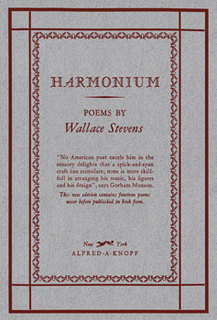Related Research Articles

Harmonium is a book of poetry by American poet Wallace Stevens. His first book at the age of forty-four, it was published in 1923 by Knopf in an edition of 1500 copies. This collection comprises 85 poems, ranging in length from just a few lines to several hundred. Harmonium was reissued in 1931 with three poems omitted and fourteen new poems added.
"Ploughing on Sunday" is a poem from Wallace Stevens's first book of poetry, Harmonium (1923). First published in 1919, it is now in the public domain.
"Cy est Pourtraicte, Madame Ste Ursule, et les Unze Mille Vierges" is a poem in Wallace Stevens's first book of poetry, Harmonium. It was first published in 1915 in the magazine Rogue, so it is in the public domain. Butell characterizes it as one of the first two poems to "successfully combine wit and elegance". They are the earliest poems to be collected later in Harmonium.
"The Doctor of Geneva" is a poem from Wallace Stevens's first book of poetry, Harmonium (1923). The poem was first published in 1921, so it is free of copyright.
"From the Misery of Don Joost" is a poem from Wallace Stevens's first book of poetry, Harmonium. It is in the public domain, having been published in the journal Poetry in 1921.
"The Apostrophe to Vincentine" is a poem from Wallace Stevens's first book of poetry, Harmonium (1923). It was first published before 1923 and is therefore in the public domain according to Librivox.
"Of the Surface of Things" is a poem from Wallace Stevens's first book of poetry, Harmonium (1923). It was first published in 1919, so it is in the public domain.
"Sunday Morning" is a poem from Wallace Stevens' first book of poetry, Harmonium. Published in part in the November 1915 issue of Poetry, then in full in 1923 in Harmonium, it is now in the public domain. The first published version can be read at the Poetry web site: The literary critic Yvor Winters considered "Sunday Morning" "the greatest American poem of the twentieth century and... certainly one of the greatest contemplative poems in English".
"The Curtains in the House of the Metaphysician" is a poem from Wallace Stevens's first book of poetry, Harmonium. It was originally published in 1919, so it is in the public domain.
"The Cuban Doctor" is a poem from Wallace Stevens's first book of poetry, Harmonium. It was first published in the journal Poetry in October 1921, so it is in the public domain.
"Tea at the Palaz of Hoon" is a poem from Wallace Stevens's first book of poetry, Harmonium. It was first published in 1921, so it is in the public domain.
"Six Significant Landscapes" is a poem from Wallace Stevens's first book of poetry, Harmonium. It was first published in 1916, so it is in the public domain.
"Bantams in Pine-Woods" is a poem from Wallace Stevens's first book of poetry, Harmonium. It was first published in 1922 in the poetry journal Dial, along with five other poems, all under the title "Revue". It is in the public domain.
"Anecdote of the Jar" is a poem from Wallace Stevens's first book of poetry, Harmonium. First published in 1919, it is in the public domain.
"Thirteen Ways of Looking at a Blackbird" is a poem from Wallace Stevens's first book of poetry, Harmonium. The poem consists of thirteen short, separate sections, each of which mentions blackbirds in some way. Although inspired by haiku, none of the sections meets the traditional definition of haiku. It was first published in October 1917 by Alfred Kreymborg in Others: An Anthology of the New Verse and two months later in the December issue of Others: A Magazine of the New Verse.
"Two Figures in Dense Violet Light" is a poem from Wallace Stevens's first book of poetry, Harmonium. It was first published in 1923, so it is still under copyright. Only its first stanza is quoted here.
"Theory" is a poem from Wallace Stevens's first book of poetry, Harmonium. It was first published in 1917, so it is in the public domain.
"The Man Whose Pharynx Was Bad" is a poem from Wallace Stevens's first book of poetry, Harmonium. First published in 1921, it is in the public domain in the United States.
"The Death of a Soldier" is a poem from Wallace Stevens's first book of poetry, Harmonium. The poem uses free verse to describe the death of a soldier.
"Tea" is a poem from Wallace Stevens' first book of poetry, Harmonium. It was first published in 1915 in the journal Rogue, so it is in the public domain.
References
- Buttel, Robert. Wallace Stevens: The Making of Harmonium. 1967: Princeton University Press.